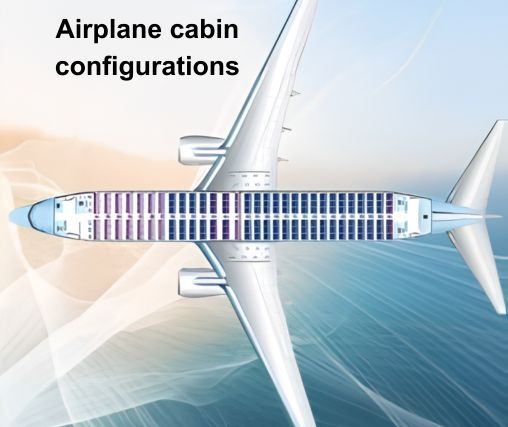Introduction
The aviation world showcases exceptional engineering and innovation. Since aviation began centuries ago, designers have always included aircraft configuration as a fundamental component. Airplane configurations cover everything from the number of engines to wing arrangements, and these choices significantly impact performance, capabilities, and intended roles. In this blog article, we explore different types of airplanes and their configurations, and we analyze the reasons behind their specific designs.
Planes come in a wide range of shapes and sizes. Designers usually shape an airplane’s configuration based on its mission needs. For example, commercial airliners feature a wide cabin in the fuselage to accommodate passengers. In contrast, military fighter jets use highly swept wings to achieve speeds faster than sound. Utility airplanes built for snow landings include skis in their landing gear. These examples clearly show how mission requirements drive aircraft design choices.
This journey through airplane configurations offers insights into how designers tailor these incredible machines for specific purposes while pushing the limits of aviation technology. Designers can meet mission requirements through various design solutions, guided by imagination, creativity, and advances in technology. The table below lists possible airplane configurations for different components. This list does not cover every option but highlights the wide range of design possibilities. We will briefly explore several configuration choices and cite real airplane design examples to better understand the range of possibilities.
| Area | Possible airplane configurations |
|---|---|
| Fuselage type | Single fuselage, twin fuselage, twin boom |
| Number of wings | Monoplane, biplane, triplane |
| Wing location | Low-wing, mid-wing, high-wing |
| Wing type | Straight, aft-swept, forward-swept |
| Horizontal tail | Aft-mounted, forward-mounted (canard), tailless |
| Vertical tail | Single or twin vertical fin |
| Propulsion | Reciprocating piston, gas turbine (jet), rocket |
| Number of engines | Single or multi-engine |
| Engine(s) location | Above or below wing, fuselage side-mounted, internal |
| Landing gear type | Wheel, skid, float, ski |
| Landing gear | Tricycle, tail wheel, bicycle |
The term "airplane configuration" describes how designers arrange and structure an aircraft, including its various parts, functions, and attributes. The intended use, performance goals, and technological advancements directly influence how engineers select a specific configuration. Let’s explore each element of aircraft configurations in more detail.
1.Wing Configuration
- Monoplane:Unlike biplanes or other types of multiplanes, which have multiple planes, a monoplane is a fixed-wing aircraft configuration with a single mainplane.
- Biplane:an older model of aircraft with two upper sets of wings.
- Triplane:Triplanes have three sets of wings, one above the other. They improve lift and maneuverability, but they are less common.
2.Engine Configuration:
- Single Engine:Many small aircraft, such as light general aviation planes, have a single engine. This configuration is simple and cost-effective.
- Twin Engine:Larger aircraft, like regional jets or some business jets, have two engines. Twin-engine designs provide redundancy and improved performance.
- Four-Engine:Typically seen on large commercial airliners like the Boeing 747 or Airbus A380, four-engine configurations offer increased thrust and range.
- Jet vs.Propeller:Modern commercial airliners commonly use jet engines because they deliver high efficiency and speed. Regional and smaller aircraft still use propeller engines, which offer better efficiency at lower speeds.
3.Landing Gear Configuration:
- Tricycle Landing Gear:Tricycle gear setups are common in modern aircraft. They consist of two main wheels under the wings and a nose wheel, providing stability during takeoff and landing.
- Taildragger:Taildraggers feature two main wheels under the wings and a tailwheel at the back. Some pilots still use them for vintage and specialty aircraft, despite their reduced ground stability.
- Retractable Landing Gear:Many modern aircraft include landing gear that retracts into the fuselage during flight. This design reduces drag and improves aerodynamics.
4.Cabin Configuration:
- Single-Aisle:Narrow-body aircraft usually have a single aisle running through the passenger cabin. They are commonly used for short to medium-haul flights.
- Wide-Body:Wide-body aircraft have multiple aisles and larger cabins to accommodate more passengers. They are intended for long-distance routes and can accommodate two aisles in a 2-4-2 or 3-3-3 seating configuration.
- Business Jet:Business jets come in a variety of cabin configurations, including spacious executive layouts, conference rooms, and even bedrooms for long-distance flights.
5.Seating Configuration:
- Economy Class:Economy class seats are usually arranged in rows, with varying seat widths and pitch (the distance between seats).
- First Class and Business Class:Premium cabins provide larger seats, more legroom, lie-flat beds, and additional amenities for a more comfortable journey.
6.Specialized Configurations:
- Military Aircraft:Military planes are classified into fighters, bombers, transporters, and reconnaissance aircraft..
- Cargo Aircraft:Cargo planes have distinct configurations with large cargo holds that enable the transportation of goods and equipment.
- Amphibious Aircraft:These aircraft have boat-like hulls and retractable landing gear, allowing them to land on both land and water.
7.Avionics Configuration:
- The cockpit of modern aircraft is equipped with advanced avionics systems, including navigation, communication, autopilot, and electronic displays.
8.Payload Configuration:
- Cargo aircraft may have specialized cargo systems, such as palletized loading or roll-on/roll-off configurations for military transport planes.
9.Fuel Configuration:
- The placement of fuel tanks and systems is carefully designed to optimize weight distribution, balance, and fuel efficiency.
10.Emergency Systems:
- Aircraft are equipped with various emergency systems, including oxygen masks, life vests, evacuation slides, and fire suppression systems.
➣ Aircraft designers choose configurations based on the intended use of each aircraft. Manufacturers continuously develop new ideas to improve performance, efficiency, and safety. As engineers introduce new technologies and design principles, aircraft configurations evolve accordingly.

